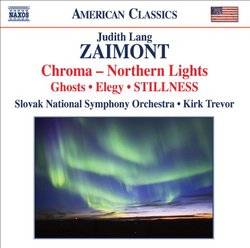A sense of color and memory
Daniel R. Coombs | Mesa, AZ United States | 05/04/2010
(5 out of 5 stars)
"Judith Lang Zaimont has been one of America's finest composers for a long time. A new disc by the Slovak National Orchestra, conducted by American Kirk Trevor showcases some of her more recent and most heartfelt orchestral output. "Chroma - Northern Lights" from 1985 is a fascinating reflection of the sense of color in the northern lights (the aurora boerealis) Commissioned by the Baltimore Chamber Orchestra, "Chroma" features changing patterns in texture and orchestral color as a way of illustrating color change in music. There are some beautiful, sparkling and attarctive solo passages for clarinet, flute and percussion in between equally captivating moments for the whole string section. Zaimont indicates that much of her music deals with memory - personal, artistic and musical; as in reflected styles and reminiscences. Both the selections, "Ghosts" and "Elegy" are a part of her 'Symphony #2 - Remember Me' and are both for a large string orchestra. In Zaimont's "Ghosts", the string section is divided into the usual sections plus an extended violin solo. The composers own "motifs" are interspersed with some taken and worked from the works of Scriabin, Britten, Berg, Chris Rouse and Laurie Anderson (!) Each composer or extract means something quite personal or evokes a memory for Zaimont. "Elegy" is structured as a continuously building song. Long stretches of melody and melodic fragments come together and the overall effect is a larger, plaintive and emotionally gripping whole. The "memory" in this case is that of the composer's aunt. "Stillness" is a near symphony length work for orchestra structured as a "poem" and intended to explore the ways that music progresses forward in ways other than traditional harmonic or melodic progression. While the piece does not "channel" any particular piece or composer, Zaimont indicates that "Stillness", composed in 2003, is a direct reflection of her study of the music of Mortin Feldman and Fredrick Delius. Tonalities are clearly developed and the three "panels" of the work are arranged internally in groups of three, such as fast-slow-fast, high-low-high. The 'stillness' both forsages the single, hanging high note but does reflect the tendency of the music of Feldman and Deliusto sound "still" while moving forward.
This is all together a very engaging and well written set of pieces by a composer who should be more familiar; something in each piece for players and audience alike and wonderfully performed by an excellent ensemble and a conductor who clearly understands the contemporary genre.
"


 Track Listings (4) - Disc #1
Track Listings (4) - Disc #1